Mendelian Randomization Analysis Provides Insights into the Pathogenesis of Serum Levels of Branched-Chain Amino Acids in Cardiovascular Disease
Abstract
1. Introduction
2. Methods
2.1. Study Overview
2.2. GWAS Summary Level Data on BCAA and CAD
2.3. GWAS Summary Level Data on CAD Clinical Event and Mediation
| Exposure/Outcome | Consortium | Participants | Web Source If Publicly Available |
|---|---|---|---|
| Mendelian randomization analysis (BCAA to CAD) | |||
| Serum BCAA | MAGNETIC NMR-GWAS [8] | 24,925 individuals of European ancestry | http://www.computationalmedicine.fi/, accessed on 27 August 2021 |
| Coronary artery disease | CARDIoGRAMplusC4Dconsortium’s 1000 Genomes-based GWAS [9] | 184,305 individuals (60,801 CAD cases and 123,504 non-cases) of mainly European (77%) and Asian (19%) ancestry | www.cardiogramplusc4d.org/, accessed on 26 May 2022 |
| Mediation analysis | |||
| Lipids | GLGC [18] | 188,577 individuals of European ancestry | csg.sph.umich.edu/abecasis/public/lipids2013/, accessed on 26 May 2022 |
| Body mass index | GIANT [15] | 339,224 individuals of mainly European (95%) ancestry | portals.broadinstitute.org/collaboration/giant/index.php/GIANT_consortium, accessed on 26 May 2022 |
| Waist-to-hip ratio | GIANT [15] | 224,459 individuals of mainly European (94%) ancestry | portals.broadinstitute.org/collaboration/giant/index.php/GIANT_consortium |
| Smoking | TAGC [17] | 74,053 individuals of European ancestry | www.med.unc.edu/pgc/results-and-downloads, accessed on 26 May 2022 |
| Blood pressure | UK Biobank | 317,756 individuals of European ancestry | http://www.nealelab.is/uk-biobank, accessed on 26 May 2022 |
| Glycaemic traits | MAGIC [16] | 46,186 non-diabetic individuals of European ancestry | www.magicinvestigators.org/, accessed on 26 May 2022 |
| Mendelian randomization analysis (BCAA to CAD clinical event) | |||
| Stroke | MEGASTROKE [13] | 446,696 individuals of European ancestry | http://www.megastroke.org/ acknowledgments.html, accessed on 26 May 2022 |
| Intracranial haemorrhage | FinnGen | 202,568 individuals of European ancestry | https://finngen.gitbook.io/documentation/, accessed on 26 May 2022 |
| Atrial fibrillation | GCST006414 [14] | 65,446 individuals of mainly European (91%) ancestry | http://www.broadcvdi.org/, accessed on 26 May 2022 |
| Cardiac arrest | FinnGen | 73,969 individuals of European ancestry | https://finngen.gitbook.io/documentation/, accessed on 26 May 2022 |
| heart attack/ myocardial infarction | UK Biobank | 317,756 individuals of European ancestry | http://www.nealelab.is/uk-biobank, accessed on 26 May 2022 |
| deep venous thrombosis | UK Biobank | 317,756 individuals of European ancestry | http://www.nealelab.is/uk-biobank, accessed on 26 May 2022 |
| Pulmonary embolism | UK Biobank | 317,756 individuals of European ancestry | http://www.nealelab.is/uk-biobank, accessed on 26 May 2022 |
2.4. Development of a Genetic Instrument for Serum BCAA Concentrations
2.5. Mediation Analysis
2.6. Meta-Analysis of Observational Studies of BCAA Levels and CAD Events
2.7. Gene Set Enrichment Analysis
2.8. Association of BCAA-Raising Loci with Other Phenotypes
2.9. Hierarchical Agglomerative Clustering, Gene Interactions and Epigenetic Effects
2.10. MR Analyses
2.11. Sensitive Analyses
2.12. Statistical Analyses
3. Results
3.1. MR Findings
3.2. Mediating Effects
3.3. Meta-Analysis Findings
3.4. BCAA Linked to Ischemic CVD Events
3.5. Preferential Associations of MRPL33 and C2orf16 Loci with MI in the Presence of Atherosclerosis
3.6. Functional Analysis of BCAA-Raising Genes
4. Discussion
5. Conclusions
Supplementary Materials
Author Contributions
Funding
Institutional Review Board Statement
Informed Consent Statement
Data Availability Statement
Conflicts of Interest
Abbreviations
| BCAA | branched amino acid |
| MR | Mendelian randomization |
| CVD | cardiovascular disease |
| CAD | coronary artery disease |
| MI | myocardial infarction |
| SNP | single-nucleotide polymorphisms |
| GWAS | genome-wide association studies |
| GTEx | Gene-Tissue Expression Project |
| BCKD | branched-chain α-keto acid dehydrogenase |
| ROS | reactive oxygen species |
| OR | odds ratio |
| CI | confidence interval |
References
- Gaziano, T.A. Cardiovascular disease in the developing world and its cost-effective management. Circulation 2005, 112, 3547–3553. [Google Scholar] [CrossRef] [PubMed]
- Bhattacharya, S.; Granger, C.B.; Craig, D.; Haynes, C.; Bain, J.; Stevens, R.D.; Hauser, E.R.; Newgard, C.B.; Kraus, W.E.; Newby, L.K.; et al. Validation of the association between a branched chain amino acid metabolite profile and extremes of coronary artery disease in patients referred for cardiac catheterization. Atherosclerosis 2014, 232, 191–196. [Google Scholar] [CrossRef] [PubMed]
- Hu, W.; Sun, L.; Gong, Y.; Zhou, Y.; Yang, P.; Ye, Z.; Fu, J.; Huang, A.; Fu, Z.; Yu, W.; et al. Relationship between Branched-Chain Amino Acids, Metabolic Syndrome, and Cardiovascular Risk Profile in a Chinese Population: A Cross-Sectional Study. Int. J. Endocrinol. 2016, 2016, 8173905. [Google Scholar] [CrossRef] [PubMed]
- Wurtz, P.; Havulinna, A.S.; Soininen, P.; Tynkkynen, T.; Prieto-Merino, D.; Tillin, T.; Ghorbani, A.; Artati, A.; Wang, Q.; Tiainen, M.; et al. Metabolite profiling and cardiovascular event risk: A prospective study of 3 population-based cohorts. Circulation 2015, 131, 774–785. [Google Scholar] [CrossRef]
- Tobias, D.K.; Lawler, P.R.; Harada, P.H.; Demler, O.V.; Ridker, P.M.; Manson, J.E.; Cheng, S.; Mora, S. Circulating Branched-Chain Amino Acids and Incident Cardiovascular Disease in a Prospective Cohort of US Women. Circ. Genom. Precis. Med. 2018, 11, e002157. [Google Scholar] [CrossRef]
- Ruiz-Canela, M.; Toledo, E.; Clish, C.B.; Hruby, A.; Liang, L.; Salas-Salvado, J.; Razquin, C.; Corella, D.; Estruch, R.; Ros, E.; et al. Plasma Branched-Chain Amino Acids and Incident Cardiovascular Disease in the PREDIMED Trial. Clin. Chem. 2016, 62, 582–592. [Google Scholar] [CrossRef]
- Zhenyukh, O.; Gonzalez-Amor, M.; Rodrigues-Diez, R.R.; Esteban, V.; Ruiz-Ortega, M.; Salaices, M.; Mas, S.; Briones, A.M.; Egido, J. Branched-chain amino acids promote endothelial dysfunction through increased reactive oxygen species generation and inflammation. J. Cell. Mol. Med. 2018, 22, 4948–4962. [Google Scholar] [CrossRef]
- Kettunen, J.; Demirkan, A.; Würtz, P.; Draisma, H.H.M.; Haller, T.; Rawal, R.; Vaarhorst, A.; Kangas, A.J.; Lyytikäinen, L.-P.; Pirinen, M.; et al. Genome-wide study for circulating metabolites identifies 62 loci and reveals novel systemic effects of LPA. Nat. Commun. 2016, 7, 11122. [Google Scholar] [CrossRef]
- Nikpay, M.; Goel, A.; Won, H.H.; Hall, L.M.; Willenborg, C.; Kanoni, S.; Saleheen, D.; Kyriakou, T.; Nelson, C.P.; Hopewell, J.C.; et al. A comprehensive 1000 Genomes-based genome-wide association meta-analysis of coronary artery disease. Nat. Genet. 2015, 47, 1121–1130. [Google Scholar] [CrossRef]
- Uddin, G.M.; Zhang, L.; Shah, S.; Fukushima, A.; Wagg, C.S.; Gopal, K.; Al Batran, R.; Pherwani, S.; Ho, K.L.; Boisvenue, J.; et al. Impaired branched chain amino acid oxidation contributes to cardiac insulin resistance in heart failure. Cardiovasc. Diabetol. 2019, 18, 86. [Google Scholar] [CrossRef] [PubMed]
- Consortium, G.T. Human genomics. The Genotype-Tissue Expression (GTEx) pilot analysis: Multitissue gene regulation in humans. Science 2015, 348, 648–660. [Google Scholar] [CrossRef]
- Uhlen, M.; Fagerberg, L.; Hallstrom, B.M.; Lindskog, C.; Oksvold, P.; Mardinoglu, A.; Sivertsson, A.; Kampf, C.; Sjostedt, E.; Asplund, A.; et al. Proteomics. Tissue-based map of the human proteome. Science 2015, 347, 1260419. [Google Scholar] [CrossRef]
- Malik, R.; Chauhan, G.; Traylor, M.; Sargurupremraj, M.; Okada, Y.; Mishra, A.; Rutten-Jacobs, L.; Giese, A.K.; van der Laan, S.W.; Gretarsdottir, S.; et al. Multiancestry genome-wide association study of 520,000 subjects identifies 32 loci associated with stroke and stroke subtypes. Nat. Genet. 2018, 50, 524–537. [Google Scholar] [CrossRef]
- Nielsen, J.B.; Thorolfsdottir, R.B.; Fritsche, L.G.; Zhou, W.; Skov, M.W.; Graham, S.E.; Herron, T.J.; McCarthy, S.; Schmidt, E.M.; Sveinbjornsson, G.; et al. Biobank-driven genomic discovery yields new insight into atrial fibrillation biology. Nat. Genet. 2018, 50, 1234–1239. [Google Scholar] [CrossRef]
- Yang, J.; Loos, R.J.; Powell, J.E.; Medland, S.E.; Speliotes, E.K.; Chasman, D.I.; Rose, L.M.; Thorleifsson, G.; Steinthorsdottir, V.; Magi, R.; et al. FTO genotype is associated with phenotypic variability of body mass index. Nature 2012, 490, 267–272. [Google Scholar] [CrossRef]
- Chen, J.; Spracklen, C.N.; Marenne, G.; Varshney, A.; Corbin, L.J.; Luan, J.; Willems, S.M.; Wu, Y.; Zhang, X.; Horikoshi, M.; et al. The trans-ancestral genomic architecture of glycemic traits. Nat. Genet. 2021, 53, 840–860. [Google Scholar] [CrossRef]
- Tobacco; Genetics, C. Genome-wide meta-analyses identify multiple loci associated with smoking behavior. Nat. Genet. 2010, 42, 441–447. [Google Scholar] [CrossRef]
- Willer, C.J.; Schmidt, E.M.; Sengupta, S.; Peloso, G.M.; Gustafsson, S.; Kanoni, S.; Ganna, A.; Chen, J.; Buchkovich, M.L.; Mora, S.; et al. Discovery and refinement of loci associated with lipid levels. Nat. Genet. 2013, 45, 1274–1283. [Google Scholar] [CrossRef]
- Bulik-Sullivan, B.; Finucane, H.K.; Anttila, V.; Gusev, A.; Day, F.R.; Loh, P.R.; ReproGen Consortium; Psychiatric Genomics Consortium; Genetic Consortium for Anorexia Nervosa of the Wellcome Trust Case Control Consortium 3; Duncan, L.; et al. An atlas of genetic correlations across human diseases and traits. Nat. Genet. 2015, 47, 1236–1241. [Google Scholar] [CrossRef]
- Richmond, R.C.; Hemani, G.; Tilling, K.; Davey Smith, G.; Relton, C.L. Challenges and novel approaches for investigating molecular mediation. Hum. Mol. Genet. 2016, 25, R149–R156. [Google Scholar] [CrossRef]
- Jiang, L.; Wang, M.; Lin, S.; Jian, R.; Li, X.; Chan, J.; Dong, G.; Fang, H.; Robinson, A.E.; Consortium, G.T.; et al. A Quantitative Proteome Map of the Human Body. Cell 2020, 183, 269–283.e19. [Google Scholar] [CrossRef]
- Hartiala, J.A.; Han, Y.; Jia, Q.; Hilser, J.R.; Huang, P.; Gukasyan, J.; Schwartzman, W.S.; Cai, Z.; Biswas, S.; Tregouet, D.A.; et al. Genome-wide analysis identifies novel susceptibility loci for myocardial infarction. Eur. Heart J. 2021, 42, 919–933. [Google Scholar] [CrossRef]
- Gilly, A.; Park, Y.C.; Png, G.; Barysenka, A.; Fischer, I.; Bjornland, T.; Southam, L.; Suveges, D.; Neumeyer, S.; Rayner, N.W.; et al. Whole-genome sequencing analysis of the cardiometabolic proteome. Nat. Commun. 2020, 11, 6336. [Google Scholar] [CrossRef]
- Kanai, M.; Akiyama, M.; Takahashi, A.; Matoba, N.; Momozawa, Y.; Ikeda, M.; Iwata, N.; Ikegawa, S.; Hirata, M.; Matsuda, K.; et al. Genetic analysis of quantitative traits in the Japanese population links cell types to complex human diseases. Nat. Genet. 2018, 50, 390–400. [Google Scholar] [CrossRef]
- Lotta, L.A.; Scott, R.A.; Sharp, S.J.; Burgess, S.; Luan, J.; Tillin, T.; Schmidt, A.F.; Imamura, F.; Stewart, I.D.; Perry, J.R.; et al. Genetic Predisposition to an Impaired Metabolism of the Branched-Chain Amino Acids and Risk of Type 2 Diabetes: A Mendelian Randomisation Analysis. PLoS Med. 2016, 13, e1002179. [Google Scholar] [CrossRef]
- Li, T.; Zhang, Z.; Kolwicz, S.C., Jr.; Abell, L.; Roe, N.D.; Kim, M.; Zhou, B.; Cao, Y.; Ritterhoff, J.; Gu, H.; et al. Defective Branched-Chain Amino Acid Catabolism Disrupts Glucose Metabolism and Sensitizes the Heart to Ischemia-Reperfusion Injury. Cell Metab. 2017, 25, 374–385. [Google Scholar] [CrossRef]
- Wu, H.; Cheng, X.W.; Hu, L.; Hao, C.N.; Hayashi, M.; Takeshita, K.; Hamrah, M.S.; Shi, G.P.; Kuzuya, M.; Murohara, T. Renin inhibition reduces atherosclerotic plaque neovessel formation and regresses advanced atherosclerotic plaques. Atherosclerosis 2014, 237, 739–747. [Google Scholar] [CrossRef]
- Hudson, J.; Cruickshank, M.; Quinton, R.; Aucott, L.; Aceves-Martins, M.; Gillies, K.; Bhasin, S.; Snyder, P.J.; Ellenberg, S.S.; Grossmann, M.; et al. Adverse cardiovascular events and mortality in men during testosterone treatment: An individual patient and aggregate data meta-analysis. Lancet Healthy Longev. 2022, 3, e381–e393. [Google Scholar] [CrossRef]
- Gannaban, R.B.; NamKoong, C.; Ruiz, H.H.; Choi, H.J.; Shin, A.C. Central Regulation of Branched-Chain Amino Acids Is Mediated by AgRP Neurons. Diabetes 2021, 70, 62–75. [Google Scholar] [CrossRef]
- Tang, W.H.; Wang, Z.; Levison, B.S.; Koeth, R.A.; Britt, E.B.; Fu, X.; Wu, Y.; Hazen, S.L. Intestinal microbial metabolism of phosphatidylcholine and cardiovascular risk. N. Engl. J. Med. 2013, 368, 1575–1584. [Google Scholar] [CrossRef]
- Xu, Y.; Jiang, H.; Li, L.; Chen, F.; Liu, Y.; Zhou, M.; Wang, J.; Jiang, J.; Li, X.; Fan, X.; et al. Branched-Chain Amino Acid Catabolism Promotes Thrombosis Risk by Enhancing Tropomodulin-3 Propionylation in Platelets. Circulation 2020, 142, 49–64. [Google Scholar] [CrossRef]
- Ward, J.H., Jr. Hierarchical grouping to optimize an objective function. J. Am. Stat. Assoc. 1963, 58, 236–244. [Google Scholar] [CrossRef]
- Mostafavi, S.; Ray, D.; Warde-Farley, D.; Grouios, C.; Morris, Q. GeneMANIA: A real-time multiple association network integration algorithm for predicting gene function. Genome Biol. 2008, 9 (Suppl. S1), S4. [Google Scholar] [CrossRef]
- Hemani, G.; Zheng, J.; Elsworth, B.; Wade, K.H.; Haberland, V.; Baird, D.; Laurin, C.; Burgess, S.; Bowden, J.; Langdon, R.; et al. The MR-Base platform supports systematic causal inference across the human phenome. Elife 2018, 7, e34408. [Google Scholar] [CrossRef]
- Burgess, S.; Thompson, S.G. Interpreting findings from Mendelian randomization using the MR-Egger method. Eur. J. Epidemiol. 2017, 32, 377–389. [Google Scholar] [CrossRef]
- Burgess, S.; Bowden, J.; Fall, T.; Ingelsson, E.; Thompson, S.G. Sensitivity Analyses for Robust Causal Inference from Mendelian Randomization Analyses with Multiple Genetic Variants. Epidemiology 2017, 28, 30–42. [Google Scholar] [CrossRef]
- Zhao, Q.; Wang, J.; Hemani, G.; Bowden, J.; Small, D.S. Statisticalinferenceintwo-Samplesummary-Datamendelian Randomization Using Robust Adjusted Profile Score. Available online: https://arxiv.org/abs/1801.09652 (accessed on 26 May 2022).
- Verbanck, M.; Chen, C.Y.; Neale, B.; Do, R. Detection of widespread horizontal pleiotropy in causal relationships inferred from Mendelian randomization between complex traits and diseases. Nat. Genet. 2018, 50, 693–698. [Google Scholar] [CrossRef]
- Hemani, G.; Bowden, J.; Davey Smith, G. Evaluating the potential role of pleiotropy in Mendelian randomization studies. Hum. Mol. Genet. 2018, 27, R195–R208. [Google Scholar] [CrossRef]
- Vitali, C.; Khetarpal, S.A.; Rader, D.J. HDL Cholesterol Metabolism and the Risk of CHD: New Insights from Human Genetics. Curr. Cardiol. Rep. 2017, 19, 132. [Google Scholar] [CrossRef]
- Yang, J.; He, X.; Qian, L.; Zhao, B.; Fan, Y.; Gao, F.; Yan, B.; Zhu, F.; Ma, X. Association between plasma proteome and childhood neurodevelopmental disorders: A two-sample Mendelian randomization analysis. EBioMedicine 2022, 78, 103948. [Google Scholar] [CrossRef]
- Sakaue, S.; Kanai, M.; Tanigawa, Y.; Karjalainen, J.; Kurki, M.; Koshiba, S.; Narita, A.; Konuma, T.; Yamamoto, K.; Akiyama, M.; et al. A cross-population atlas of genetic associations for 220 human phenotypes. Nat. Genet. 2021, 53, 1415–1424. [Google Scholar] [CrossRef]
- Wang, Z.; Tang, W.H.; Buffa, J.A.; Fu, X.; Britt, E.B.; Koeth, R.A.; Levison, B.S.; Fan, Y.; Wu, Y.; Hazen, S.L. Prognostic value of choline and betaine depends on intestinal microbiota-generated metabolite trimethylamine-N-oxide. Eur. Heart J. 2014, 35, 904–910. [Google Scholar] [CrossRef]
- Neinast, M.D.; Jang, C.; Hui, S.; Murashige, D.S.; Chu, Q.; Morscher, R.J.; Li, X.; Zhan, L.; White, E.; Anthony, T.G.; et al. Quantitative Analysis of the Whole-Body Metabolic Fate of Branched-Chain Amino Acids. Cell Metab. 2019, 29, 417–429.e4. [Google Scholar] [CrossRef]
- Shimomura, Y.; Yamamoto, Y.; Bajotto, G.; Sato, J.; Murakami, T.; Shimomura, N.; Kobayashi, H.; Mawatari, K. Nutraceutical effects of branched-chain amino acids on skeletal muscle. J. Nutr. 2006, 136, 529S–532S. [Google Scholar] [CrossRef]
- Oyarzabal, A.; Martinez-Pardo, M.; Merinero, B.; Navarrete, R.; Desviat, L.R.; Ugarte, M.; Rodriguez-Pombo, P. A novel regulatory defect in the branched-chain alpha-keto acid dehydrogenase complex due to a mutation in the PPM1K gene causes a mild variant phenotype of maple syrup urine disease. Hum. Mutat. 2013, 34, 355–362. [Google Scholar] [CrossRef]
- Giuseppe, D.A.; Maurizio, R.; Annalisa, C.; Laura, T.; Marta, D.; Flavia, B.; Francesca, C.; Giovanni, C.; Roberto, B.; Carruba, M.O. Branched-chain amino acid supplementation promotes survival and supports cardiac and skeletal muscle mitochondrial biogenesis in middle-aged mice. Cell Metab. 2010, 12, 362–372. [Google Scholar]
- Sun, H.; Olson, K.C.; Gao, C.; Prosdocimo, D.A.; Zhou, M.; Wang, Z.; Jeyaraj, D.; Youn, J.Y.; Ren, S.; Liu, Y.; et al. Catabolic Defect of Branched-Chain Amino Acids Promotes Heart Failure. Circulation 2016, 133, 2038–2049. [Google Scholar] [CrossRef]
- Yoneshiro, T.; Wang, Q.; Tajima, K.; Matsushita, M.; Maki, H.; Igarashi, K.; Dai, Z.; White, P.J.; McGarrah, R.W.; Ilkayeva, O.R.; et al. BCAA catabolism in brown fat controls energy homeostasis through SLC25A44. Nature 2019, 572, 614–619. [Google Scholar] [CrossRef]
- Voight, B.F.; Peloso, G.M.; Orho-Melander, M.; Frikke-Schmidt, R.; Barbalic, M.; Jensen, M.K.; Hindy, G.; Holm, H.; Ding, E.L.; Johnson, T.; et al. Plasma HDL cholesterol and risk of myocardial infarction: A mendelian randomisation study. Lancet 2012, 380, 572–580. [Google Scholar] [CrossRef]
- Holmes, M.V.; Asselbergs, F.W.; Palmer, T.M.; Drenos, F.; Lanktree, M.B.; Nelson, C.P.; Dale, C.E.; Padmanabhan, S.; Finan, C.; Swerdlow, D.I.; et al. Mendelian randomization of blood lipids for coronary heart disease. Eur. Heart J. 2015, 36, 539–550. [Google Scholar] [CrossRef]
- Kanter, J.E.; Bornfeldt, K.E. Evidence stacks up that endothelial insulin resistance is a culprit in atherosclerosis. Circ. Res. 2013, 113, 352–354. [Google Scholar] [CrossRef]
- Shinobu, N.; Kenji, T.; Shoji, F.; Ichiro, S. Branched-chain amino acids improve glucose metabolism in rats with liver cirrhosis. Am. J. Physiol. Gastrointest. Liver Physiol. 2005, 288, 1292–1300. [Google Scholar]
- Zhang, S.; Zeng, X.; Man, R.; Mao, X.; Qiao, S. Novel metabolic and physiological functions of branched chain amino acids: A review. J. Anim. Sci. Biotechnol. 2017, 8, 10. [Google Scholar] [CrossRef]
- Hirai, H.; Pang, Z.D.; Miyazaki, T.; Li, L.; Miura, E.; Parris, J.; Rong, Y.; Watanabe, M.; Yuzaki, M.; Morgan, J.I. Cbln1 is essential for synaptic integrity and plasticity in the cerebellum. Nat. Neurosci. 2005, 8, 1534–1541. [Google Scholar] [CrossRef]
- Gardiner, J.V.; Beale, K.E.; Roy, D.; Boughton, C.K.; Bataveljic, A.; Campbell, D.C.; Bewick, G.A.; Patel, N.A.; Patterson, M.; Leavy, E.M.; et al. Cerebellin1 is a novel orexigenic peptide. Diabetes Obes. Metab. 2010, 12, 883–890. [Google Scholar] [CrossRef]
- Wang, L.; Rao, F.; Zhang, K.; Mahata, M.; Rodriguez-Flores, J.L.; Fung, M.M.; Waalen, J.; Cockburn, M.G.; Hamilton, B.A.; Mahata, S.K.; et al. Neuropeptide Y(1) Receptor NPY1R discovery of naturally occurring human genetic variants governing gene expression in cella as well as pleiotropic effects on autonomic activity and blood pressure in vivo. J. Am. Coll. Cardiol. 2009, 54, 944–954. [Google Scholar] [CrossRef]
- Collier, B.; Katz, H.S. Acetylcholine synthesis from recaptured choline by a sympathetic ganglion. J. Physiol. 1974, 238, 639–655. [Google Scholar] [CrossRef]
- Petty, A.C.; Scrutton, M.C. Release of Choline Metabolites from Human Platelets: Evidence for Activation of Phospholipase D and of Phosphatidylcholine-specific Phospholipase C. Platelets 1993, 4, 23–29. [Google Scholar] [CrossRef]
- Mohanta, S.K.; Peng, L.; Li, Y.; Lu, S.; Sun, T.; Carnevale, L.; Perrotta, M.; Ma, Z.; Forstera, B.; Stanic, K.; et al. Neuroimmune cardiovascular interfaces control atherosclerosis. Nature 2022, 605, 152–159. [Google Scholar] [CrossRef]
- Karwi, Q.G.; Lopaschuk, G.D. Branched-Chain Amino Acid Metabolism in the Failing Heart. Cardiovasc. Drugs Ther. 2022. [Google Scholar] [CrossRef]
- Portero, V.; Nicol, T.; Podliesna, S.; Marchal, G.A.; Baartscheer, A.; Casini, S.; Tadros, R.; Treur, J.L.; Tanck, M.W.T.; Cox, I.J.; et al. Chronically elevated branched chain amino acid levels are pro-arrhythmic. Cardiovasc. Res. 2022, 118, 1742–1757. [Google Scholar] [CrossRef]
- Zhang, X.; Lin, Q.; Chen, J.; Wei, T.; Li, C.; Zhao, L.; Gao, H.; Zheng, H. High Glucose-Induced Cardiomyocyte Death May Be Linked to Unbalanced Branched-Chain Amino Acids and Energy Metabolism. Molecules 2018, 23, 807. [Google Scholar] [CrossRef]
- Wang, Z.; Yang, T.; Fu, H. Prevalence of diabetes and hypertension and their interaction effects on cardio-cerebrovascular diseases: A cross-sectional study. BMC Public Health 2021, 21, 1224. [Google Scholar] [CrossRef]
- Yang, Y.; Wu, Z.; Meininger, C.J.; Wu, G. L-Leucine and NO-mediated cardiovascular function. Amino Acids 2015, 47, 435–447. [Google Scholar] [CrossRef]
- Macari, F.; El-Houfi, Y.; Boldina, G.; Xu, H.; Khoury-Hanna, S.; Ollier, J.; Yazdani, L.; Zheng, G.; Bieche, I.; Legrand, N.; et al. TRM6/61 connects PKCalpha with translational control through tRNAi(Met) stabilization: Impact on tumorigenesis. Oncogene 2016, 35, 1785–1796. [Google Scholar] [CrossRef]
- Zhenyukh, O.; Civantos, E.; Ruiz-Ortega, M.; Sanchez, M.S.; Vazquez, C.; Peiro, C.; Egido, J.; Mas, S. High concentration of branched-chain amino acids promotes oxidative stress, inflammation and migration of human peripheral blood mononuclear cells via mTORC1 activation. Free Radic. Biol. Med. 2017, 104, 165–177. [Google Scholar] [CrossRef]
- Ussher, J.R.; Elmariah, S.; Gerszten, R.E.; Dyck, J.R. The Emerging Role of Metabolomics in the Diagnosis and Prognosis of Cardiovascular Disease. J. Am. Coll. Cardiol. 2016, 68, 2850–2870. [Google Scholar] [CrossRef]
- Sun, H.; Wang, Y. Branched Chain Amino Acid Metabolic Reprogramming in Heart Failure. BBA Mol. Basis Dis. 2016, 1862, 2270–2275. [Google Scholar] [CrossRef]
- Angeloni, E.; Paneni, F.; Landmesser, U.; Benedetto, U.; Melina, G.; Lüscher, T.F.; Volpe, M.; Sinatra, R.; Cosentino, F. Lack of protective role of HDL-C in patients with coronary artery disease undergoing elective coronary artery bypass grafting. Eur. Heart J. 2013, 34, 3557–3562. [Google Scholar] [CrossRef]
- Schnabel, R.B.; Schulz, A.; Messow, C.M.; Lubos, E.; Wild, P.S.; Zeller, T.; Sinning, C.R.; Rupprecht, H.J.; Bickel, C.; Peetz, D.; et al. Multiple marker approach to risk stratification in patients with stable coronary artery disease. Eur. Heart J. 2010, 31, 3024–3031. [Google Scholar] [CrossRef]
- Mahendran, Y.; Jonsson, A.; Have, C.T.; Allin, K.H.; Witte, D.R.; Jørgensen, M.E.; Grarup, N.; Pedersen, O.; Kilpeläinen, T.O.; Hansen, T. Genetic evidence of a causal effect of insulin resistance on branched-chain amino acid levels. Diabetologia 2017, 60, 873–878. [Google Scholar] [CrossRef]
- Larsson, S.C.; Markus, H.S. Branched-chain amino acids and Alzheimer’s disease: A Mendelian randomization analysis. Sci. Rep. 2017, 7, 13604. [Google Scholar] [CrossRef]
- Staley, J.R.; Burgess, S. Semiparametric methods for estimation of a nonlinear exposure-outcome relationship using instrumental variables with application to Mendelian randomization. Genet. Epidemiol. 2017, 41, 341–352. [Google Scholar] [CrossRef]
- Burgess, S.; Davies, N.M.; Thompson, S.G.; Consortium, E.P.-I. Instrumental variable analysis with a nonlinear exposure-outcome relationship. Epidemiology 2014, 25, 877–885. [Google Scholar] [CrossRef]
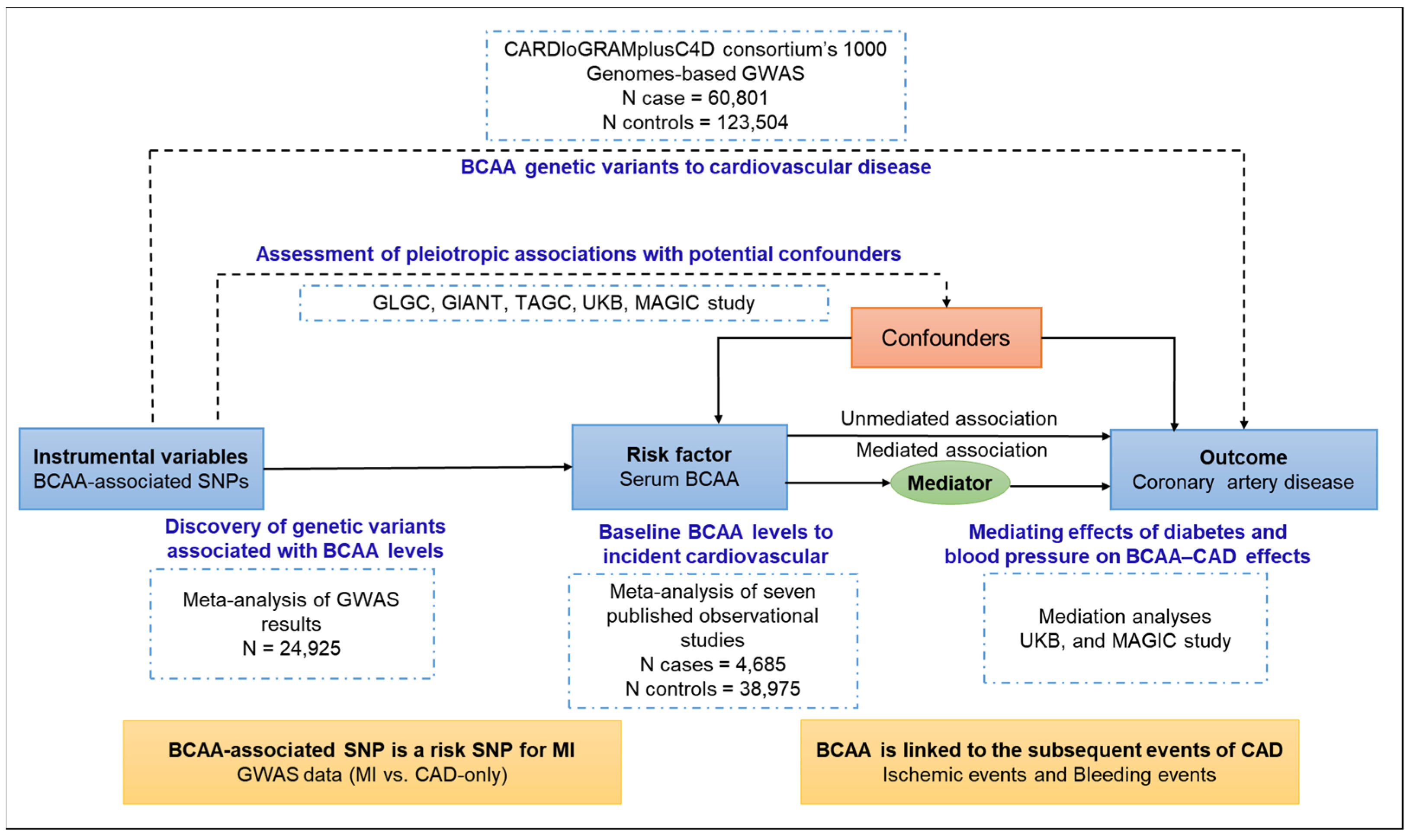

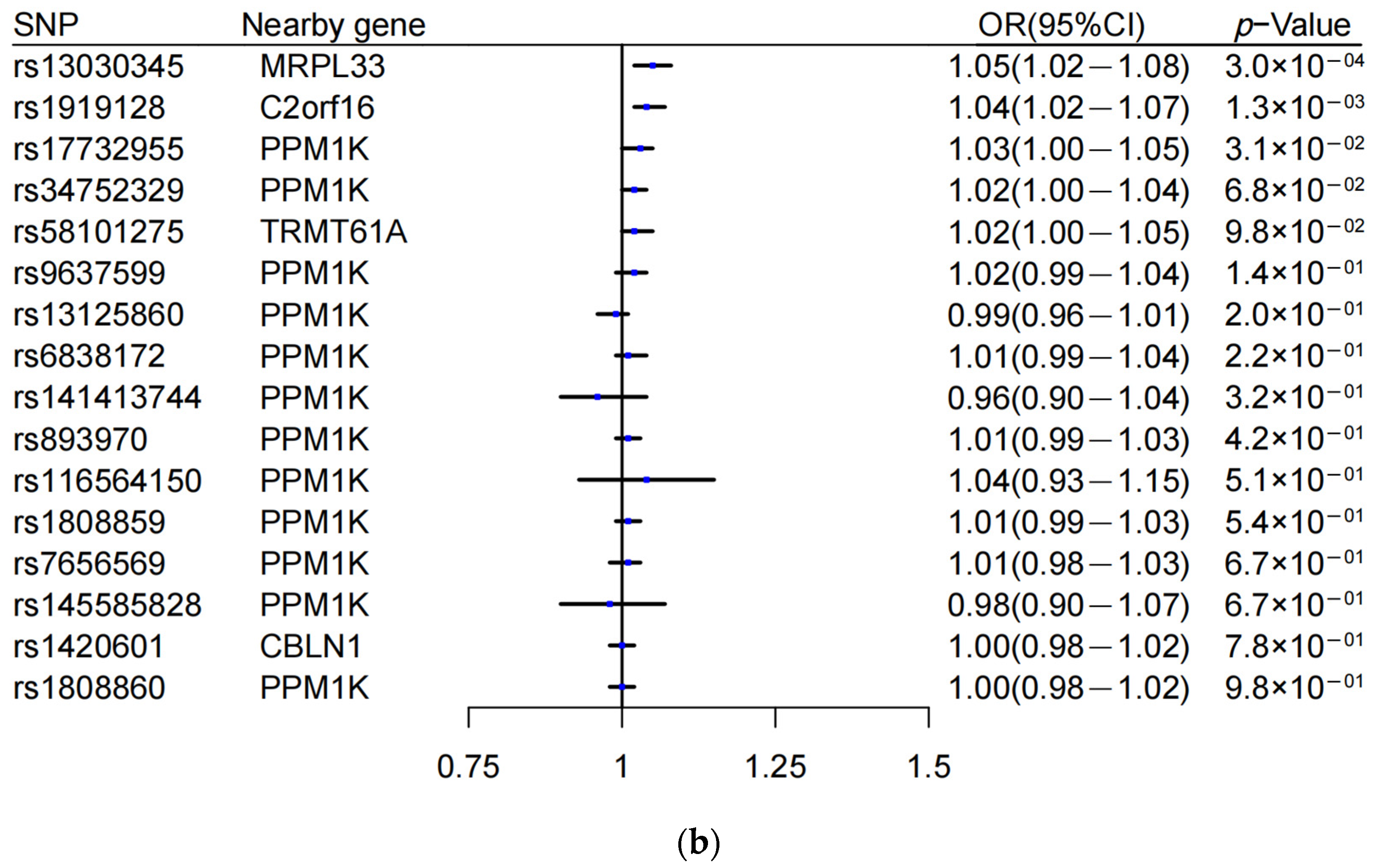
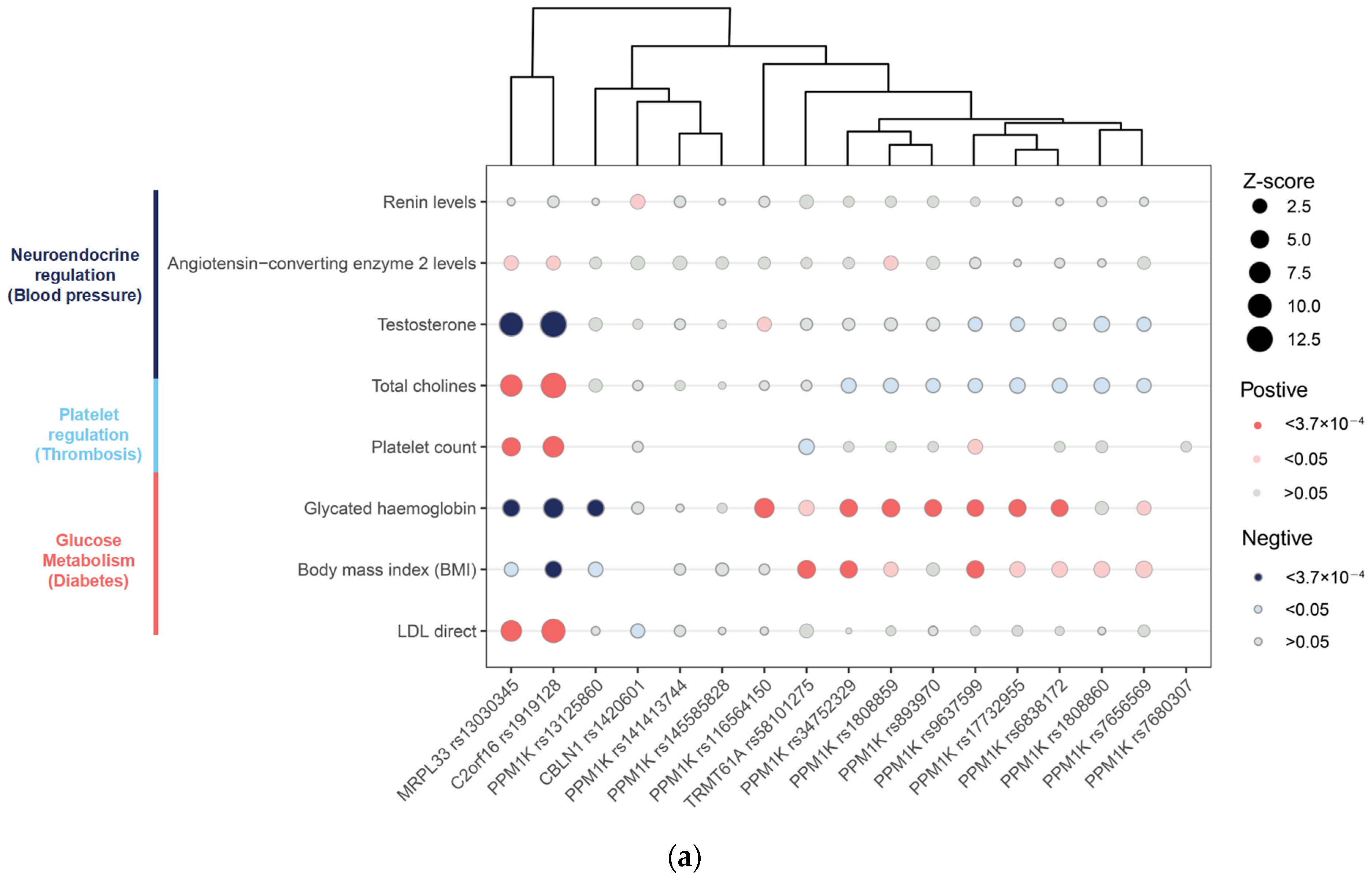
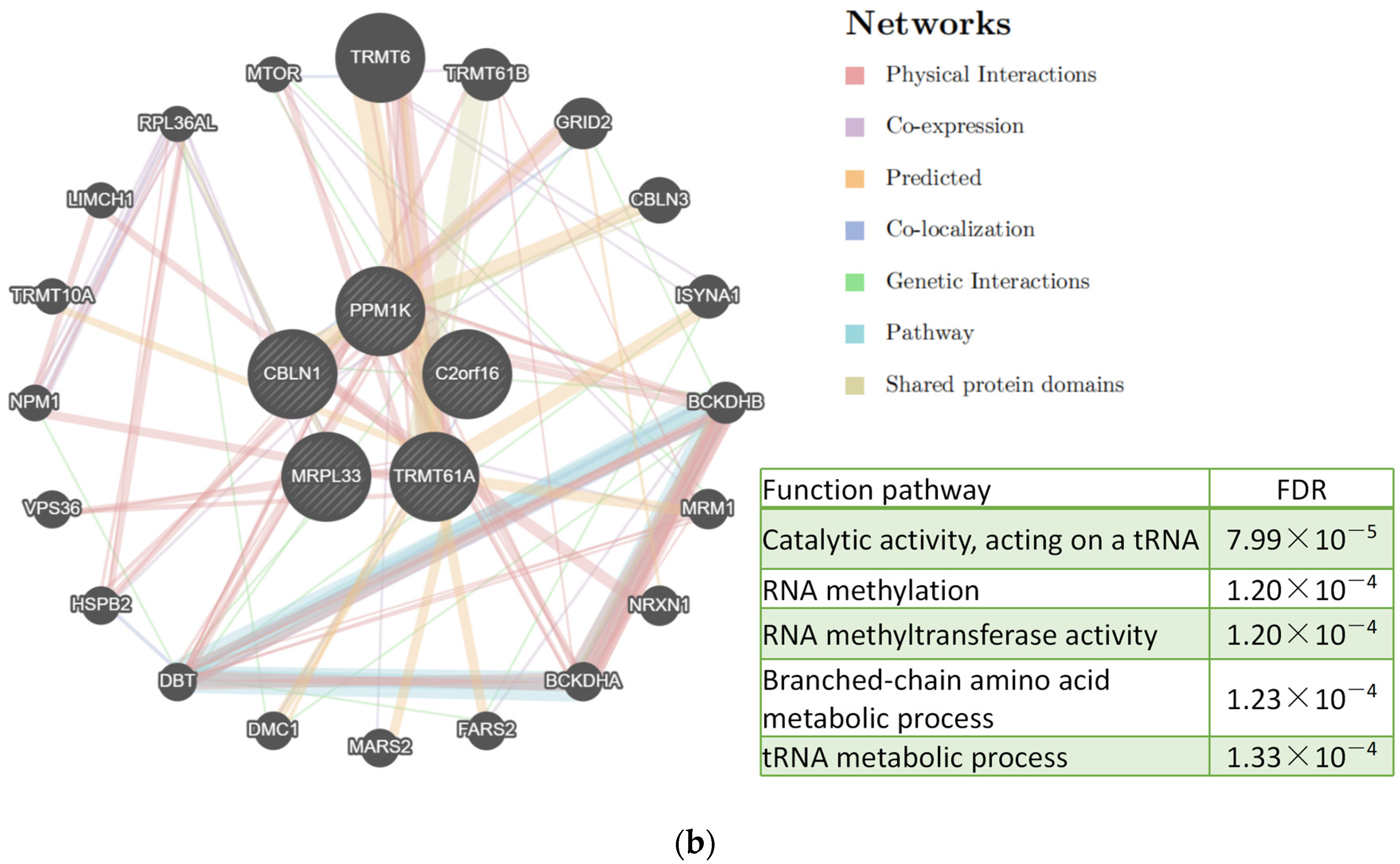
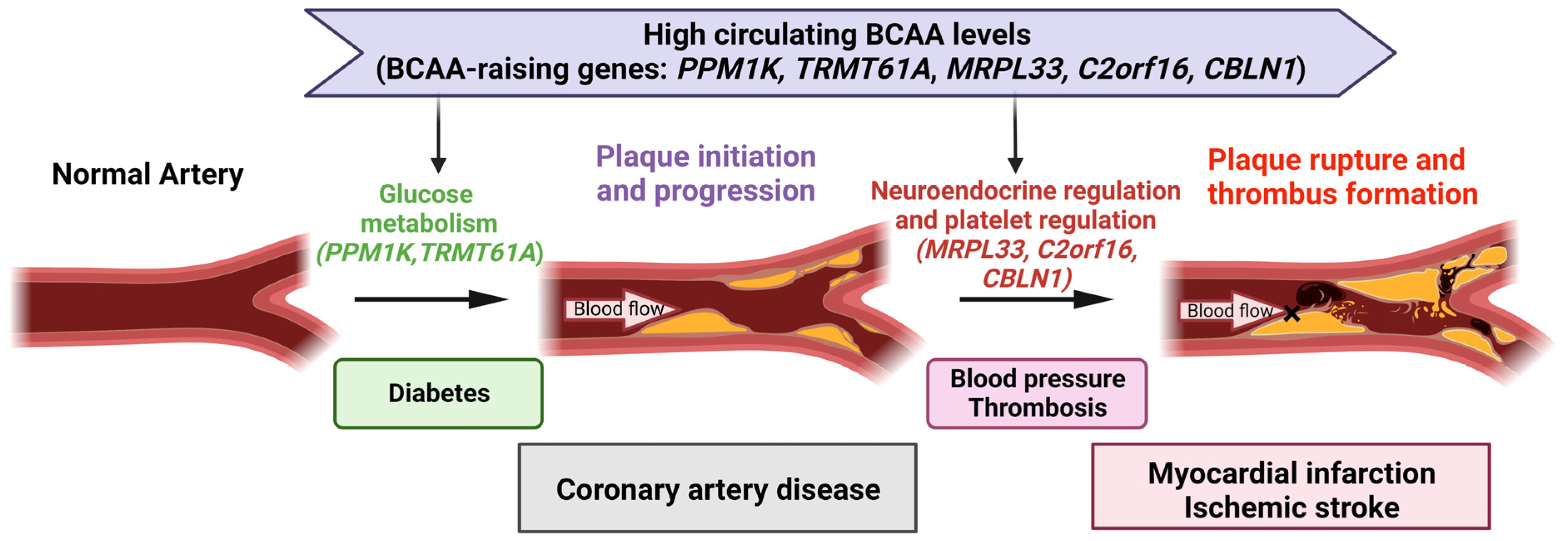
| SNP | Nearby Gene | Chromosome | Effect/Other Alleles | Effect Allele Frequency | Beta(Se) of BCAAs Level Per Alleles1 | p-Value 1 | OR(95%CI) for CAD Per Alleles 2 | p-Value 2 |
|---|---|---|---|---|---|---|---|---|
| rs116564150 | PPM1K | 4 | A/G | 0.013 | 0.31(0.05) | 5.79 × 10−12 | 1.07(0.97,1.18) | 0.188 |
| rs145585828 | PPM1K | 4 | A/C | 0.016 | −0.25(0.04) | 2.06 × 10−9 | 1.01(0.93,1.11) | 0.753 |
| rs141413744 | PPM1K | 4 | C/T | 0.037 | −0.20(0.03) | 1.24 × 10−14 | 1.02(0.95,1.11) | 0.555 |
| rs1808860 | PPM1K | 4 | C/T | 0.436 | 0.11(0.01) | 1.95 × 10−31 | 1.01(0.99,1.03) | 0.458 |
| rs34752329 | PPM1K | 4 | A/G | 0.369 | 0.11(0.01) | 5.69 × 10−30 | 1.01(0.99,1.03) | 0.286 |
| rs6838172 | PPM1K | 4 | A/G | 0.320 | 0.11(0.01) | 5.68 × 10−27 | 1.01(0.99,1.03) | 0.348 |
| rs7680307 | PPM1K | 4 | C/T | 0.259 | 0.11(0.01) | 5.87 × 10−20 | 1.01(0.99,1.04) | 0.421 |
| rs9637599 | PPM1K | 4 | C/A | 0.470 | 0.11(0.01) | 7.64 × 10−36 | 1.00(0.98,1.02) | 0.757 |
| rs13125860 | PPM1K | 4 | A/T | 0.389 | −0.10(0.01) | 1.69 × 10−25 | 1.00(0.98,1.02) | 0.904 |
| rs17732955 | PPM1K | 4 | T/C | 0.295 | 0.10(0.01) | 1.09 × 10−22 | 1.02(1.00,1.04) | 0.116 |
| rs1808859 | PPM1K | 4 | C/T | 0.391 | 0.10(0.01) | 5.92 × 10−26 | 1.00(0.98,1.02) | 0.696 |
| rs58101275 | TRMT61A | 14 | G/A | 0.790 | 0.09(0.02) | 9.87 × 10−10 | 1.01(0.99,1.04) | 0.222 |
| rs893970 | PPM1K | 4 | C/T | 0.447 | 0.09(0.01) | 2.98 × 10−19 | 1.00(0.98,1.02) | 0.689 |
| rs13030345 | MRPL33 | 2 | T/G | 0.191 | 0.07(0.01) | 4.52 × 10−9 | 1.01(0.98,1.03) | 0.488 |
| rs1420601 | CBLN1 | 16 | C/T | 0.400 | 0.07(0.01) | 3.63 × 10−8 | 1.01(0.99,1.03) | 0.244 |
| rs1919128 | C2orf16 | 2 | G/A | 0.275 | 0.07(0.01) | 1.18 × 10−10 | 1.01(0.99,1.03) | 0.422 |
| rs7656569 | PPM1K | 4 | A/C | 0.202 | 0.07(0.01) | 6.74 × 10−9 | 1.01(0.98,1.04) | 0.464 |
| Method 1 | Beta | Se | OR(95%CI) | p-Value |
|---|---|---|---|---|
| Inverse variance weighted | 0.076 | 0.028 | 1.08(1.02,1.14) | 0.007 |
| Weighted median | 0.078 | 0.038 | 1.08(1.01,1.16) | 0.037 |
| Simple median | 0.097 | 0.040 | 1.10(1.02,1.19) | 0.011 |
| MR-RAPS | 0.077 | 0.029 | 1.08(1.02,1.14) | 0.009 |
| MR-PRESSO | 0.076 | 0.017 | 1.08(1.04,1.12) | 0.0003 |
| Beta(Se) 1 | p Value 1 | Mediation Effect (%) 2 | |
|---|---|---|---|
| Systolic blood pressure | 0.566(0.091) | <0.001 | 34.2% |
| Diastolic blood pressure | 0.581(0.076) | <0.001 | 15.2% |
| Type 2 diabetes | 0.110(0.028) | <0.001 | 33.5% |
Disclaimer/Publisher’s Note: The statements, opinions and data contained in all publications are solely those of the individual author(s) and contributor(s) and not of MDPI and/or the editor(s). MDPI and/or the editor(s) disclaim responsibility for any injury to people or property resulting from any ideas, methods, instructions or products referred to in the content. |
© 2023 by the authors. Licensee MDPI, Basel, Switzerland. This article is an open access article distributed under the terms and conditions of the Creative Commons Attribution (CC BY) license (https://creativecommons.org/licenses/by/4.0/).
Share and Cite
Jiang, W.; Lu, K.; Zhuang, Z.; Wang, X.; Tang, X.; Huang, T.; Gao, P.; Wang, Y.; Du, J. Mendelian Randomization Analysis Provides Insights into the Pathogenesis of Serum Levels of Branched-Chain Amino Acids in Cardiovascular Disease. Metabolites 2023, 13, 403. https://doi.org/10.3390/metabo13030403
Jiang W, Lu K, Zhuang Z, Wang X, Tang X, Huang T, Gao P, Wang Y, Du J. Mendelian Randomization Analysis Provides Insights into the Pathogenesis of Serum Levels of Branched-Chain Amino Acids in Cardiovascular Disease. Metabolites. 2023; 13(3):403. https://doi.org/10.3390/metabo13030403
Chicago/Turabian StyleJiang, Wenxi, Ke Lu, Zhenhuang Zhuang, Xue Wang, Xun Tang, Tao Huang, Pei Gao, Yuan Wang, and Jie Du. 2023. "Mendelian Randomization Analysis Provides Insights into the Pathogenesis of Serum Levels of Branched-Chain Amino Acids in Cardiovascular Disease" Metabolites 13, no. 3: 403. https://doi.org/10.3390/metabo13030403
APA StyleJiang, W., Lu, K., Zhuang, Z., Wang, X., Tang, X., Huang, T., Gao, P., Wang, Y., & Du, J. (2023). Mendelian Randomization Analysis Provides Insights into the Pathogenesis of Serum Levels of Branched-Chain Amino Acids in Cardiovascular Disease. Metabolites, 13(3), 403. https://doi.org/10.3390/metabo13030403





